1973 CHEVROLET CAMARO check engine
[x] Cancel search: check enginePage 30 of 84
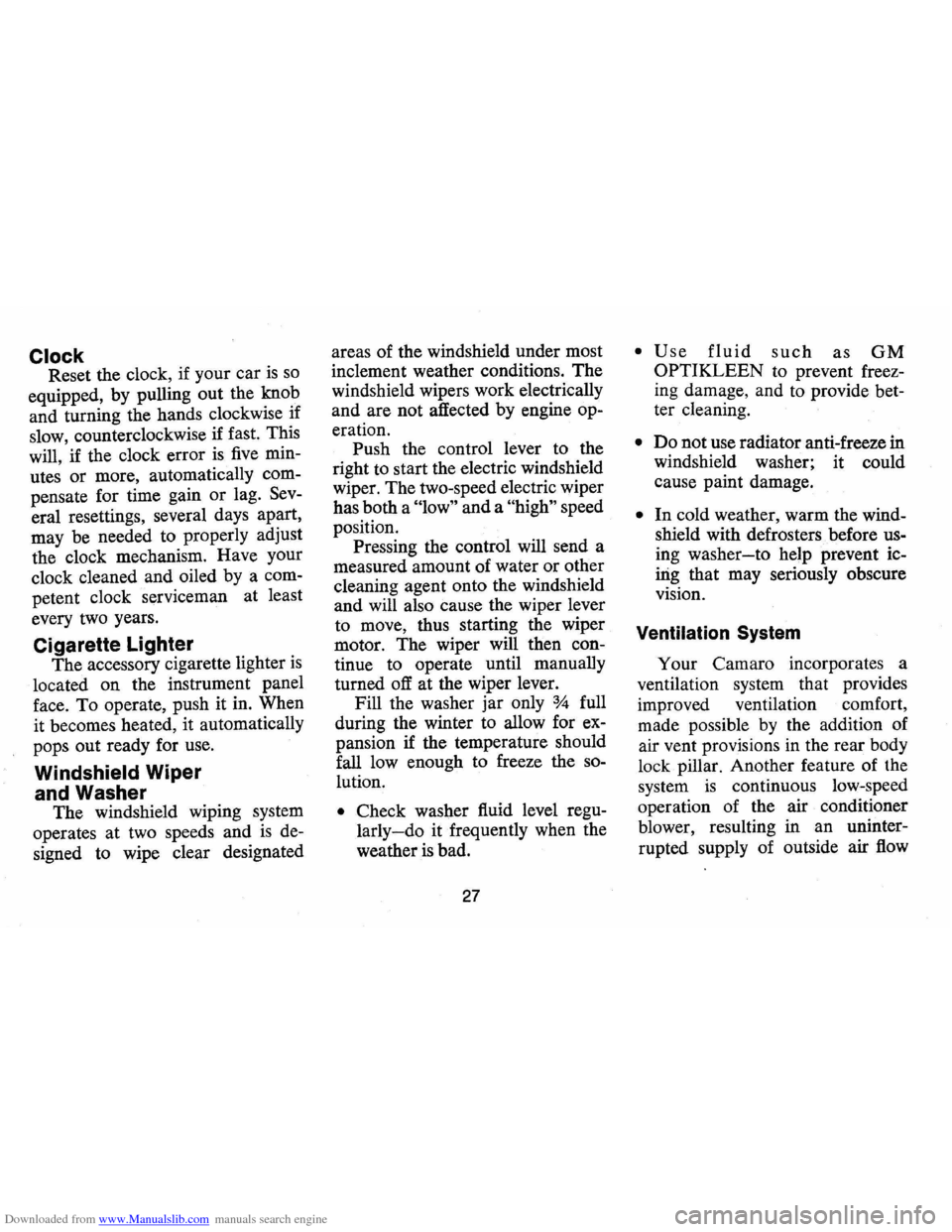
Downloaded from www.Manualslib.com manuals search engine Clock Reset the clock, if your car is so
equipped, by pulling out the knob
and turning the hands clockwise if
slow, counterclockwise if fast. This
will, if the clock error
is five min
utes or more, automatically com
pensate for time gain
or lag. Sev
eral resettings, several days apart,
may be needed to properly adjust
the clock mechanism. Have your
clock cleaned and oiled by a com
petent clock serviceman at least
every two years.
Cigarette Lighter
The accessory cigarette lighter is
located on the instrument panel
face.
To operate, push it in. When
it becomes heated, it automatically
pops out ready for use.
Windshield Wiper
and Washer
The windshield wiping system
operates at two speeds and
is de
signed to wipe clear designated areas
of the windshield under most
inclement weather conditions. The
windshield wipers work electrically
and are not affected by engine op
eration. Push the control lever to the
right to start the electric windshield
wiper. The two-speed electric wiper
has both a
"low" and a "high" speed
position. Pressing the control will send a
measured amount of water or other
cleaning agent onto the windshield
and will also cause the wiper lever
to move, thus starting the wiper
motor. The wiper will then con
tinue to operate until manually
turned off at the wiper lever.
Fill the washer jar only
% full
during the winter to allow for ex
pansion if the temperature should
fall low enough to freeze the so
lution.
• Check washer fluid level regu
larly-do it frequently when the
weather is bad.
27
• Use fluid such as GM
OPTIKLEEN to prevent freez
ing damage, and to provide bet
ter cleaning.
• Do not use radiator anti-freeze in
windshield washer; it could
cause paint damage.
• In cold weather, warm the wind
shield with defrosters before us
ing
washer-to help prevent ic
fig that may seriously obscure
vision.
Ventilation System
Your Camaro incorporates a
ventilation system that provides
improved ventilation comfort,
made possible by the addition of
air vent provisions in the rear body
lock pillar. Another feature of the
system
is continuous low-speed
operation of the air conditioner
blower, resulting
in an uninter
rupted supply of outside air
flow
Page 43 of 84
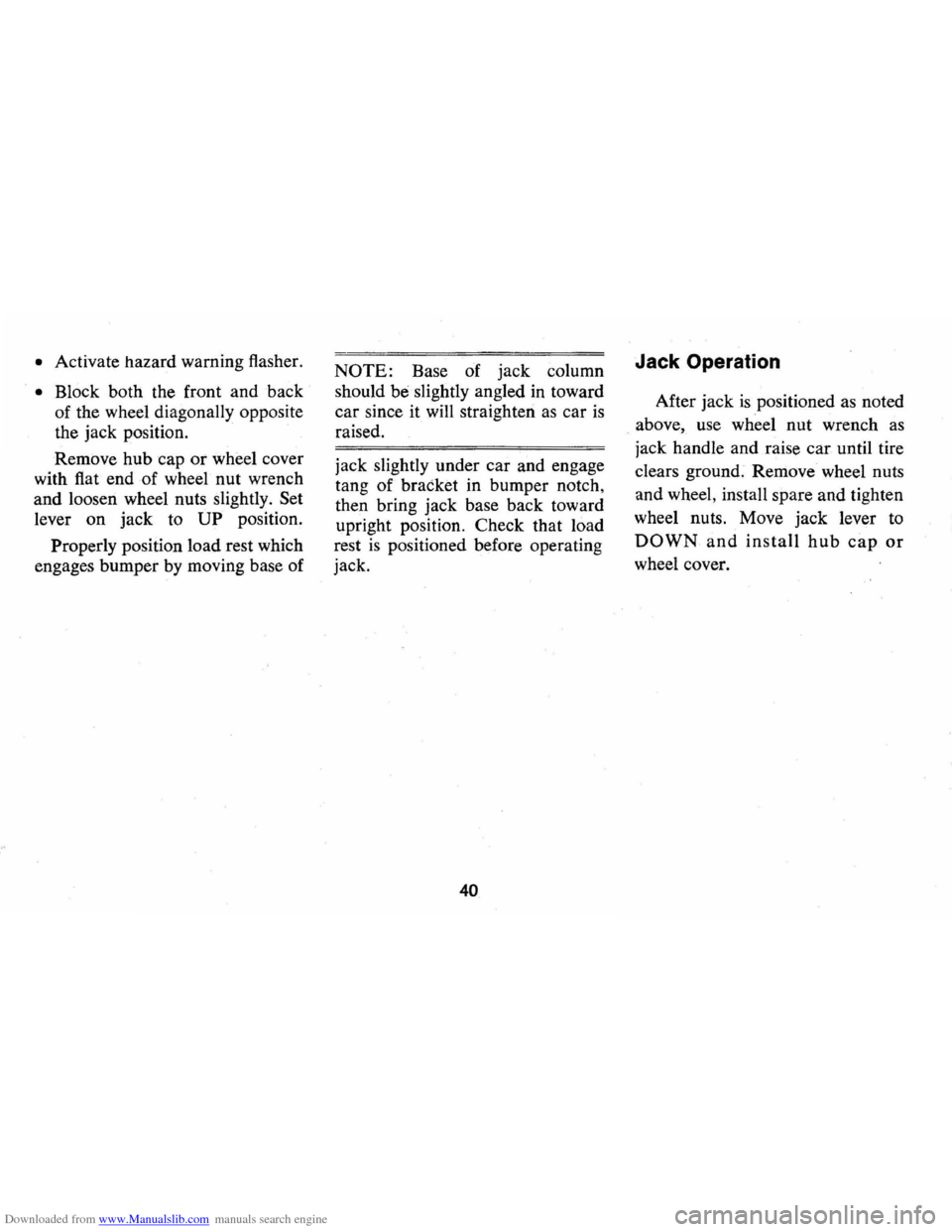
Downloaded from www.Manualslib.com manuals search engine • Activate hazard warning flasher.
• Block both the front and back
of the wheel diagonally opposite
the jack position.
Remove
hubcap or wheel cover
with flat end of wheel
nut wrench
and loosen wheel nuts slightly.
Set
lever on jack to UP position.
Properly position load rest which
engages bumper by moving base of
NOTE: Base of jack column
should be slightly angled in toward
car since it will straighteri
as car is
raised.
jack slightly under car and engage
tang of
bracket in bumper notch,
then bring jack base back toward
upright position. Check that
l~ad
rest is positioned before operatmg
jack.
40
Jack Operation
After jack is positioned as noted
above use
wheel nut wrench as . ,
jack handle and raise car until tire
clears ground. Remove wheel nuts
and wheel, install spare and tighten
wheel nuts. Move jack lever to
DOWN and install hub cap or
wheel cover.
Page 50 of 84
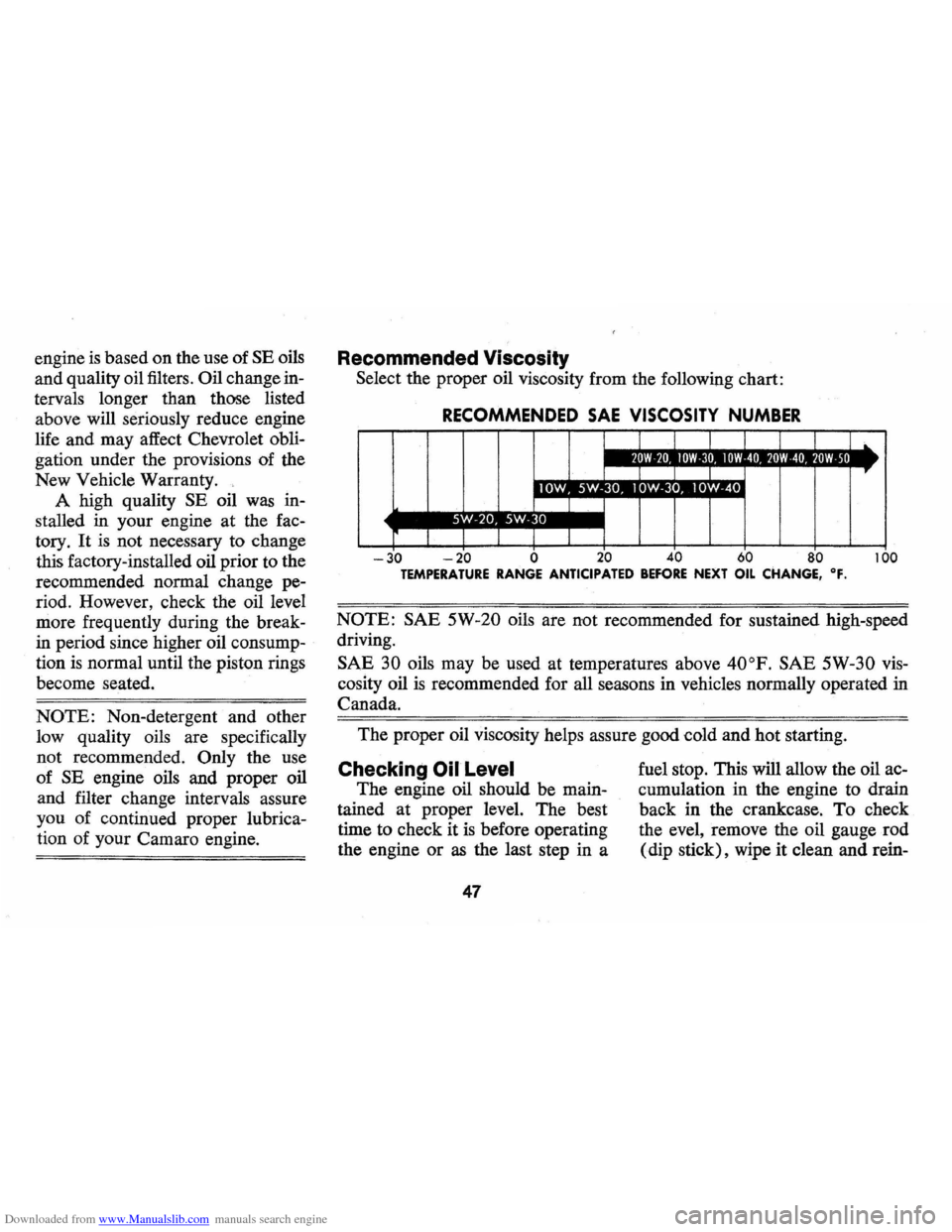
Downloaded from www.Manualslib.com manuals search engine engine is based on the use of SE oils
and quality oil filters.
Oil change in
tervals longer than those listed
above will seriously reduce engine
life and may affect Chevrolet obli
gation under the provisions of the
New Vehicle Warranty.
A high quality
SE oil was in
stalled in your engine at the fac
tory.
It is not necessary to change
this factory-installed oil prior to the
recommended normal change pe
riod. However, check the oil level
more frequently during the break
in period since higher oil consump
tion
is normal until the piston rings
become seated.
NOTE: Non-detergent and other
low quality oils are specifically
not recommended.
Only the use
of
SE engine oils and proper oil
and filter change intervals assure
you of continued proper lubrica
tion of your Camaro engine.
Recommended Viscosity
Select the proper oil viscosity from the following chart:
RECOMMENDED SAE VISCOSITY NUMBER
I I _111'1.11 11II'laU.III'11 .. 1_111'.'l!! :1. 11'1&'1_
I I
. I
I r I
-30 -20 0 20 40 60 80 100 TEMPERATURE RANGE ANTICIPATED BEFORE NEXT OIL CHANGE, OF.
NOTE: SAE 5W-20 oils are not recommended for sustained high-speed
driving.
SAE 30 oils may be used at temperatures above 40oP. SAE 5W-30 vis
cosity oil is recommended for all seasons in vehicles normally operated in
Canada.
The proper oil viscosity helps assure good cold and hot starting.
Checking Oil Level
The engine oil should be main
tained at proper level. The best
time to check it
is before operating
the engine
or as the last step in a
47
fuel stop. This will allow the oil ac
cumulation in the engine to drain
back in the crankcase. To check
the
eve!, remove the oil gauge rod
(dip stick), wipe it clean and rein-
Page 51 of 84

Downloaded from www.Manualslib.com manuals search engine sert it firmly for an accurate read
ing. The oil gauge rod
is marked
"FULL" and "ADD." The oil level
should be maintained in the safety
margin, neither going above the
"FULL" line nor below the "ADD"
line. Reseat the gauge firmly after
taking the reading.
NOTE: The oil gauge rod is also
marked
"Use SE Engine Oil" as a
reminder to use only
SE oils.
Supplemental Engine Oil
Additives
The regular use of supplemental
additives
is specifically not recom
mended and will increase operat
ing costs. However, supplemental
additives are available that can
effectively and economically solve
certain specific problems without
causing other difficulties. For ex
ample,
if higher detergency is re
quired to reduce varnish and sludge
deposits resulting from
some unusual operational diffi
culty, a thoroughly tested and ap
proved additive -
"Super Engine
Oil Supplement" -is available at
your Chevrolet dealer.
In the event
of an operational problem, consult
your dealer for advice before
us
ing supplemental additives.
Drive Belts
Every 6,000 miles or 4 months
inspect drive belts for wear, fray
ing, cracking, and tension. Belts
which are in poor condition should
be replaced immediately.
Check tension by applying mod
erate thumb pressure midway be
tween pulleys.
If the center-to
center distance between pulleys
is
13 to 16 inches, the belt should
deflect
Y2 inch . If the center-to
center distance
is7 to 10 inches,
the belt should deflect
1.4 inch.
Loose belts should be retensioned
48
to give the correct deflection.
Air Cleaner
Flame Arrester -Every 12,000
miles-Clean the arrester (located
in the base of the air cleaner) with
kerosene
or a suitable solvent. Dry
with compressed air.
Rear Axle
Standard -Every 4 months or
6,000 miles, whichever occurs
first, check lubricant level and add
lubricant, if necessary, to fill to
level of filler plug hole.
Use SAE
80 or SAE 90 GL-5 Gear Lubri
cant.
(For vehicles normally oper
ated in Canada use SAE 80 GL-5
Gear Lubricant.)
Page 52 of 84

Downloaded from www.Manualslib.com manuals search engine Positraction -Drain and refill
after the first
12,000 miles then
maintain same
as standard axle but
use only the special positraction
lubricant available from your
Chevrolet Dealer.
Manual Transmissions
3-Speed and 4-Speed -Every
6,000 miles or 4 months-Check
at operating temperature and
fill
as necessary to level of filler plug
hole with
SAE 80 or SAE 90 GL-
5 Gear Lubricant.
(For vehicles
normally operated in Canada use
SAE 80 GL-5 Gear Lubricant.)
If temperatures of below 3Z°F.
are expected, use SAE 80 GL-5
Gear Lubricant only.
Clutch Cross-Shaft -Every
36,000 miles or sooner if neces
sary -Remove the plug, install a
lubrication fitting and lubricate
with water resistant
EP Chassis
Lubricant which meets GM
Speci
fication 6031 M.
Automatic Transmission
Fluid Recommendations
Use only automatic transmis
sion fluids identified with the
mark
DEXRON. These fluids have
been specially formulated and
tested for
use in your automatic
transmission, and are available
from your Chevrolet dealer or lo
cal service station.
Check the fluid level at each
engine oil change period. To make
an accurate fluid level check:
Check the fluid level at each en
gine oil change period.
To make an
accurate fluid level check:
1. Drive car several miles, making
frequent starts and stops, to
bring transmission up to normal
operating temperature (approxi
mately
180-190° F.).
2. Park car on a level surface.
3.
Place selector level in "Park"
and leave engine running.
49
4. Remove dipstick and wipe clean.
5. Reinsert dipstick until cap seats.
6. Remove dipstick and note read
ing.
If fluid level is at or below the
ADD mark, add sufficient fluid to
raise the level to the
FULL mark.
One pint raises the level from ADD
to FULL.
Do not overfill.
Under normal driving condi
tions, the transmission fluid should
be changed every
24,000 miles. If
your car is driven extensively in
heavy city traffic during hot weather,
or
is used to pull a trailer, change
fluid every
12,000 miles. Likewise,
operators of cars in commercial use
(such as taxicab, limousine
or pa
trol car service) where the engine
idles for long periods, should
change fluid every
12,000 miles.
Changing Fluid-For Turbo Hy
dra-Matic
350, remove fluid from
Page 53 of 84

Downloaded from www.Manualslib.com manuals search engine the transmission sump and add ap
proximately 2.5 quarts U.S. Mea
sure
(2.0 quarts Imperial Mea
sure). Operate transmission
through all shift ranges and re
check fluid level as described
above.
Turbo Hydra-Matic 400-Lubri
cation of your Turbo Hydra-matic
400 will, except for fluid capacity
and filter change listed below, fol
low previously stated automatic
transmission recommendations.
After checking transmission fluid
level it
is important that the dip
stick be pushed all the way into
the filler tube.
Every 24,000 miles -After re
moving fluid from the transmission
sump, approximately
71h. pints
U.S. measure (6 pints Imperial
measure) of fresh fluid will be re
quired to return level to proper mark
on the dipstick.
Every 24,000 miles the transmis
sion sump filter should be re
placed.
Transmission Shift and Back
drive Linkage (Manual and
Automatic) -
Every 6,000 miles
or 4 months lubricate shift link
age and on manual transmission
floor controls lever contacting
faces with water
resistantEP chas
sis lubricant which meets GM
Specification 6031M.
Transmission Shift Linkage
(Manual and Automatic)
Every 6,000 miles or 4 months
lubricate shift linkage and on man
ual transmission floor controls
lever contacting faces with water
resistant
EP chassis lubricant
which meets
GM Specification
6031M.
50
Chassis
Front Suspension
Every 6,000 miles or 4 months
-Lubricate 4 fittings · with water
resistant
EP Chassis Lubricant
which meets
GM Specification
6031M.
Ball joints should not be lu
bricated unless their tempera
ture
is 10°F. or higher. During
colder weather, they should be
allowed to warm up as neces
sary before lubrication.
Steering Linkage
Every 6,000 miles or 4 months
-Lubricate 7 fittings, one at each
end of each tie rod, one at each
end of relay rod, and one
at idler
lever with water resistant
EP Chas
sis Lubricant which meets
GM
Specification 6031 M.
Page 54 of 84
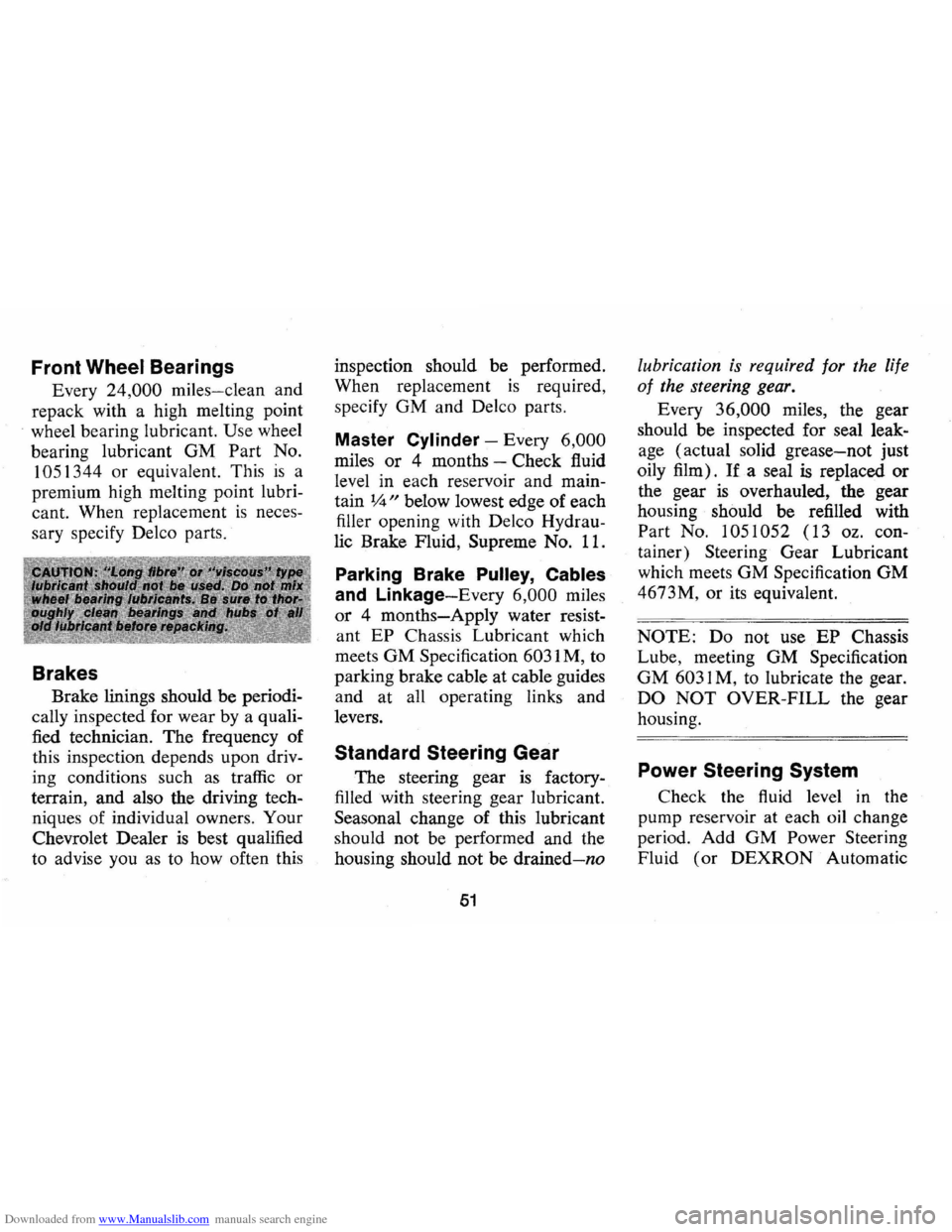
Downloaded from www.Manualslib.com manuals search engine Front Wheel Bearings
Every 24,000 miles-clean and
repack with a high melting point
wheel bearing lubricant.
Use wheel
bearing lubricant GM Part No.
1051344 or equivalent. This is a
premium high melting point lubri
cant. When replacement is neces
sary specify Delco parts.
Brakes
Brake linings should. be periodi
cally inspected for wear by a quali
fied technician. The frequency of
thi s inspection depends upon driv
ing conditions such
as traffic or
terrain, and also the driving tech
niques of individual owners.
Your
Chevrolet Dealer is best qualified
to advise you
as to how often this inspection
should be performed.
When replacement
is required ,
specify
GM and Delco parts.
Master Cylinder -Every 6,000
miles or 4 months -Check fluid
level in each reservoir and main
tain
1;4" below lowest edge of each
filler opening with Delco Hydrau
lic Brake Fluid,
Supreme No. 11.
Parking Brake Pulley, Cables
and Linkage-Every 6,000 miles
or 4 months-Apply water resist
ant EP Chassis Lubricant which
meets
GM Specification 6031 M, to
parking brake cable at cable guides
and at all operating links and
levers.
Standard Steering Gear
The steering gear is factory
filled with steering gear lubricant.
Seasonal change of this lubricant
should not be performed and the
housing should not be
drained-no
51
lubrication is required for the life
of the steering gear.
Every 36,000 miles, the gear
should be inspected for seal leak
age (actual solid
grease-not just
oily film) .
Ifa seal is replaced or
the gear is overhauled, the gear
housing should be refilled with
Part No.
105 1052 (13 oz. con
tainer) Steering Gear Lubricant
which meets GM Specification GM
4673M, or
its equivalent.
NOTE: Do not use EP Chassis
Lube, meeting
GM Specification
GM 603 I M, to lubricate the gear.
DO NOT OVER-FILL the gear
housing.
Power Steering System
Check the fluid level in the
pump reservoir at each oil change
period. Add GM Power Steering
Fluid
(or DEXRON Automatic
Page 55 of 84
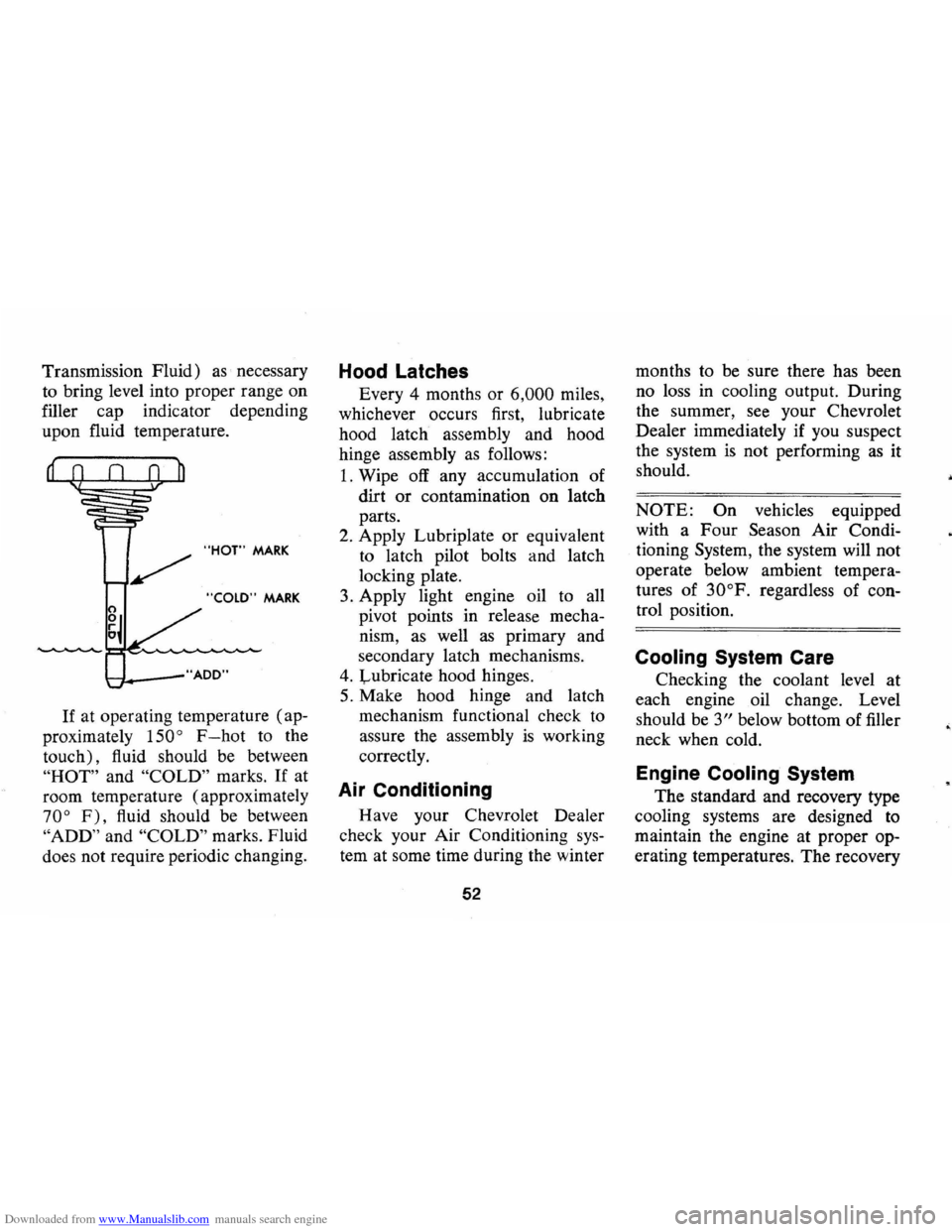
Downloaded from www.Manualslib.com manuals search engine Transmission Fluid) as necessary
to bring level into proper range on
filler cap indicator depending
upon fluid temperature .
"HOT" MARK
"COLD" MARK
t-"f. __ -"AOO"
If at operating temperature (ap
proximately
150 ° F-hot to the
touch), fluid should be between
"HOT" and "COLD" marks. If at
room temperature (approximately
70° F), fluid should be between
"ADD" and "COLD" marks . Fluid
does not require periodic changing.
Hood Latches
Every 4 months or 6,000 miles,
whichever occurs first, lubricate
hood latch assembly and hood
hinge assembly
as follows:
1. Wipe off any accumulation of
dirt
or contamination on latch
parts.
2. Apply Lubriplate or equivalent
to latch pilot bolts and latch
locking plate.
3. Apply light engine oil to all
pivot points in release mecha
nism,
as well as primary and
secondary latch mechanisms.
4. Lubricate hood hinges.
5. Make hood hinge and latch
mechanism functional check to
assure the assembly
is working
correctly.
Air Conditioning
Have your Chevrolet Dealer
check your Air Conditioning
sys
tem at some time during the winter
52
months to be sure there has been
no loss
in cooling output. During
the summer,
see your Chevrolet
Dealer immediately if you suspect
the system
is not performing as it
should.
NOTE: On vehicles equipped
with a Four
Season Air Condi
tioning
System, the system will not
operate below ambient tempera
tures of
30°F. regardless of con
trol position.
Cooling System Care
Checking the coolant level at
each engine oil change. Level
should be
3" below bottom of filler
neck when cold.
Engine Cooling System
The standard and recovery type
cooling systems are designed
to
maintain the engine at proper op
erating temperatures. The recovery
•